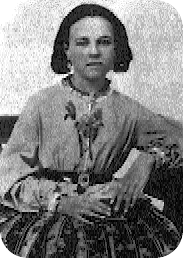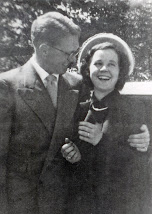Wednesday, July 28, 2010
Sunday, July 25, 2010
Remembering Our Pioneer Heritage - Agnes Caldwell Southworth
Isn't is incredible that there are so many young children in this family that are well acquainted with their great-grandparents? The picture of young Jack skiing with his great grandpa is one that I'll always cherish along with the other photos of Grandma and Grandpa celebrating baby blessings on a regular basis. It wasn't that long ago that many of the now adult 'Generation 3' grandkids were able to sing songs and play games with their Great-Grandma Veara Southworth Fife.
Grandma Norda is one of very few (the only one that I know of) who can tell a story about her grandmother and her journey across the plains as part of the Willie Handcart company. Over the years I've related this story in Primary, Sacrament meetings and even Stake Conference and I've heard the story told in General Conference and Church-wide firesides.
Grandma's grandpa Southworth was also a young pioneer. Chester Southworth III crossed the plains as a young 9 year old boy with the John B Walker Wagon Company.
Grandpa Emmett once joked that the Emmetts were
Agnes Caldwell Southworth
 Born: 1847 Died: 1924
Born: 1847 Died: 1924
Children's Story: Nine year old Agnes was a member of the 1856 Willie Handcart Company. She was blessed by the forethought and preparation of her mother and did not suffer as much as others.
Biography: © 1994 Deseret Book Company. All rights reserved.
Born:
Parents: William and Margaret Ann McFall Caldwell
1856: James G. Willie Handcart Company
Age at time of journey: 9
Although only tender years of age, I can yet close my eyes and see everything in panoramic precision before me-the ceaseless walking, walking, ever to remain in my memory. Many times I would become so tired and, childlike, would hang on the cart, only to be gently pushed away. Then I would throw myself by the side of the road and cry. Then realizing they were all passing me by, I would jump to my feet and make an extra run to catch up.
Of the long cold journey, the suffering, and hardships, enough has been told and written, of that terrible night when fifteen were frozen and buried in one grave. My sister Elizabeth Caldwell had her foot frozen. Two of her toes were amputated upon our arrival in the
Winter came in October with eighteen inches of snow, but in spite of this we did not suffer from hunger, due to Mother's careful and frugal planning. In Iowa City Mother sold a quilt and a bedspread for the sum of twenty-four cents. With this she bought food. She had a way with Indians: she traded trinkets for dried meat, which proved to be of great help to us on the journey. Frequently it would be stormy so that a fire could not be built; then mother would allow each of us to have a piece of dried meat on a piece of bread. As food became more and more scarce and the weather colder, she would stew a little of this meat and make a delicious gravy over it. I guess the reason it tasted so good is that we were allowed only a small portion at each meal.
One very cold night, some young men were on guard. Mother prepared some meat broth, thickened with flour, and a little salt; she gave each one of the young men a half pint. They often declared it saved their lives and never before or since had anything tasted so good.
For baking, Mother dug a hole in the ground. The food was placed in a heavy iron kettle with a tight lid on, then set in the hole and covered over with buffalo chips, which were set afire. This produced a nice, even heat, baking the food evenly.
One day we came to a section inhabited by rattlesnakes. Two of us, my friend Mary Hurren and I, would hold hands and jump. It seemed to me we were jumping for more than a mile. Due to the protecting hand of the Lord, we were not harmed.
The 30th of September we stopped at a station in
Just before we crossed the mountains, relief wagons reached us, and it certainly was a relief. The infirm and aged were allowed to ride, all able-bodied continuing to walk. When the wagons started out, a number of us children decided to see how long we could keep up with the wagons, in hopes of being asked to ride. At least that is what my great hope was. One by one they all fell out, until I was the last one remaining, so determined was I that I should get a ride. After what seemed the longest run I ever made before or since, the driver, who was Heber [William Henry] Kimball, called to me, "Say, sissy, would you like a ride?" I answered in my very best manner, "Yes sir." At this he reached over, taking my hand, clucking to his horses to make me run, with legs that seemed to me could run no farther. On we went, to what to me seemed miles. What went through my head at that time was that he was the meanest man that ever lived or that I had ever heard of, and other things that would not be a credit nor would it look well coming from one so young. Just at what seemed the breaking point, he stopped. Taking a blanket, he wrapped me up and lay me in the bottom of the wagon, warm and comfortable. Here I had time to change my mind, as I surely did, knowing full well by doing this he saved me from freezing when taken into the wagon.
Agnes Caldwell and her family arrived safely in the
Source: "Autobiography of Agnes Caldwell," typescript of interview conducted by Vera Southworth Fife, her daughter. Original in files of Daughters of Utah Pioneers Museum in
Posted by
emetski
at
10:48 PM
1 comments
![]()
Remembering Our Pioneer Heritage - Charles Heber Dudley
Their children are: Charles Heber Jr., Dorothy Elta, Mary Ann, George Benjamin, Hannah Ida, Harriet,
In 1889 Charles Heber Dudley of Willard Utah entered into a contract with the Alberta Irrigation Company to build a mile of canal in
While in
Leaving
Two of the children, Dora and Harriet, years later, told of the fun that they had running up the hill onto the roof of the dug-in and down again until "father" put an end to it. The next day the children had great fun building a raft out of slabs and sailing on the pond in front of their new home.
It didn't take Dorothy long to set up respectable housekeeping. She divided the dug-in into four rooms by slab partitions, hung building paper on the slabs and layered cloth on that. A coat of kalsomine was then added. On the floor was a thin layer of straw with rag rugs from wall to wall. Two bedrooms were added later. Dorothy was creative in making everything in her domain beautiful. She was an expert seamstress and would often find the most exquisite dress in the exclusive shops and then would go home and make it. She was also a wonderful cook. Breads, cakes, cookies, pies, fondants, chocolates,
In July, 1902 it rained and rained, causing flooding in the valley. The water rose so fast that the family had to crawl out the north window of the dug-in to higher ground. The organ was lifted onto a table to save it. They moved into the grainery for three days until they could reach safe ground when the water receded. They had no clean water and almost died of thirst, until Sammy Wallace swam a horse over to bring some water. The floor of their home was covered with a silty mud. Dorothy and her girls made it cozy and livable again in short order.
After the flood, a new six room home was built by
The kitchen was in the south end of the home while the living room was in the north. The entrance way was off the kitchen on the southeast side. There were internal stairs on the east wall rising to the south. The bedrooms were upstairs. The Wallace's (Dorothy's family) had a nursery in Salt Lake, so she was particular with the grounds and was concerned when the grass would never grow on a patch of ground on the north side of the house. This remained a mystery until Charles finally realized that the north room was the boys bedroom.
During the winter months, Dorothy and her children had great fun sliding on scoop shovelsdown the hill on the east side of the house out on to the frozen pond. As there was no refrigeration, ice was used from the pond, later known as Ovard's pond. It was cut and hauled up the hill and stored in an underground cellar (ice house), which was about 60 feet east of the house. Packed in ashes, the ice remained frozen and was sold in the summer. Alan has found many artifacts from this and other structures from that era while digging water lines etc. About 100 feet southeast of the house was the chicken coop. It was on a small rise of ground with the stable beyond that. The garden was south of the barn. The spring was toward the creek (pond) about 150 feet southeast of the house and is still there and running.
It has been a labor of love for Alan Dudley to be able to purchase the land and have it once again to be the
Additional tid-bits
Dororthy Ann was a practical nurse and began her midwife career during the flood of 1902 out of necessity. She later went on to deliver 200 - 300 babies in the Magrath -Raymond district. Her charge was $1.50, and this included delivering the baby and 10 days of care for the mother and child. One experience she had was in the dead of winter during a terrible blizzard when a man came to her to deliver a baby in the country, When they got there, snow was drifting into the cabin onto the woman's bed. Dorothy Ann delivered the baby but the after- birth would not come, Knowing the woman was hemorrhaging, Dorothy went into a closet and prayed, asking what to do. A voice gave her instructions, which she followed exactly, and was able to save the woman's life. Because of her great faith, she could tell many faith promoting experiences.
Charles Heber was an ambitious, frugal, and a very religious man. Every morning the family would read from the scriptures and then would turn their chairs with the backs to the table and have a kneeling family prayer. He was the first ward clerk and also the town secretary in Magrath. He always had peppermints in his pockets to give to the kids. One funny story told of Charles Heber was when he got his first car. The boys drove it out from
A favorite story tells of the Rasmus Rasmussen family and their neighborly buck sheep. One morning, while the
This write up was taken from Alison Shaw’s website: http://members.shaw.ca/familytreasures/ch_dudley_sr_.htm
Posted by
emetski
at
6:18 PM
3
comments
![]()















